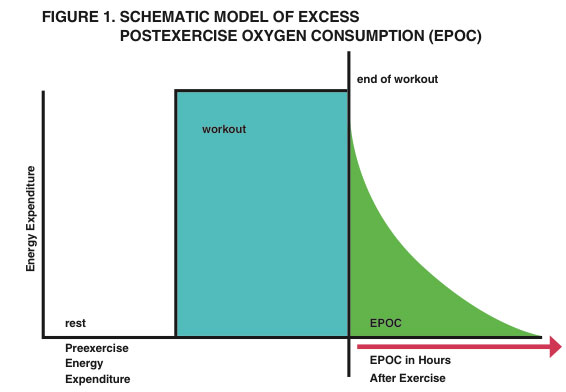
Research Sheds New Light on the Exercise “Afterburn”
Some of us call it “afterburn”—the elevated calorie burning that lasts long after exercise is over. The scientific literature defines it as excess postexercise oxygen consumption, or EPOC (see Figure 1).
For the most part, EPOC represents the body restoring itself from physiological variables elevated by exercise. EPOC is an important physiological phenomenon for fitness professionals because it can play a contributing role in weight management.
One of the key questions about EPOC is how long it actually lasts. The science is conflicting: Some studies suggest EPOC lasts no more than 35 minutes, while others report 24 hours (Børsheim Bahr attribute the conflicts to differences in exercise intensity, duration and mode (cardiovascular, resistance training, circuit training). Furthermore, scientific methodologies and technologies for measuring EPOC vary widely (Knab et al. 2011).

Source: Adapted from Gaesser & Brooks 1984.
Despite these differences, recent studies still offer guidance on EPOC that personal trainers can apply directly when designing programs for clients.
Background on EPOC
Though elevated metabolism after exercise was first noted in the 1920s, a groundbreaking investigation by Glen Gaesser and George Brooks in 1984 resolved many conflicting ideas and explained several previously unknown mechanisms of EPOC. Gaesser and Brooks comprehensively clarified that the chemical and physical changes (see Figure 2) in the body’s contracting cells during exercise—which elevate oxygen metabolism—persist during recovery, causing a meaningful amount of EPOC.
The authors further explained that muscle cells need this elevated oxygen metabolism to restore themselves to preexercise levels. Contemporary studies on EPOC describe the training load of exercise as a “homeostatic stress” or “disturbance” to physiological and metabolic processes that happens during exercise and after it has ended (Mann et al. 2014).
How Does Exercise Intensity Affect EPOC?
Independently, exercise intensity is the strongest factor influencing EPOC (Børsheim Bahr 2003). In a 2014 study, Mann et al. investigated the recovery rate for 20 minutes of running after bouts at 60%, 70% and 80% of VO2max in 38 male and female runners aged 20–40. Substantiating previous research, the 80%-of-VO2max bout (the highest intensity) had the greatest afterburn from the 15 minutes of measured EPOC.

Source: Adapted from Gaesser & Brooks 1984.
Testing EPOC in a Metabolic Chamber
In one unique study, Knab et al. (2011) investigated EPOC in a metabolic chamber—a small, roomlike enclosed space where subjects can live independently for up to 24 hours or longer. These chambers allow scientists to measure precisely how exercise, food, sleep and physical movement affect metabolic rate.
Knab and colleagues recruited 10 healthy 25-year-old men to find out how they would respond to exercising at 70% of VO2max for 45 minutes on a cycle ergometer in a metabolic chamber. The authors chose 45 minutes because it corresponds to the middle of the range (30–60 minutes) suggested by the physical activity guidelines for Americans.
The men were told to avoid exercise for a few days before the trials and were given a specific food list for a diet comprising 55% carbohydrate, 15% protein and 30% fat. To control all variables affecting energy metabolism, the men completed two 24-hour trials in the metabolic chamber on nonconsecutive days (Mondays and Wednesdays or Tuesdays and Thursdays).
For the control trial, the men stayed in the chamber for 24 hours (starting at 8:00 am) in a rested state, eating a similar diet. This established true resting energy expenditure for 24 hours. In the second trial, the men reported to the metabolic chamber at the same time, but did a 45-minute cycle ergometer workout at 11:00 am. The scientists provided extra snacks and food in the meals (for the 24 hours in the chamber) to match the number of calories each man expended in the 45-minute cycle bout.
Results showed that the 45-minute workout had an average energy cost of 519 kilocalories. Afterward, the resting energy expenditure, or EPOC, was significantly elevated for 14 hours—an increase of 190 kcal compared with the resting-day trial. This study suggests that vigorous-intensity exercise of moderate duration (45 minutes) results in very meaningful EPOC (190 kcal).
How Does High-Intensity Resistance Training vs. Traditional Resistance Training Influence EPOC?
In a pioneering investigation, Paoli et al (2012) compared the EPOC effects of traditional resistance training (TRD) with those of high-intensity resistance training (HIRT), testing 17 men (aged 28 ± 4) who had 4–6 years of resistance training experience. All 17 completed both the TRD trial and the HIRT trial, which were held 7 days apart, with the sequence randomly determined for each subject. They ate a standardized breakfast (55% carbohydrate, 25% protein, 20% fat), after which they performed one of the workouts; during the rest of the day, they ate similar meals (provided by researchers). The men maintained their daily life activities and then reported back to the laboratory 22 hours later to have their EPOC measured.
TRD Protocol
The TRD used 4 sets of eight exercises: bench press, latissimus dorsi pull-down, military press, bicep curls, triceps extension, leg press, leg curl and sit-up. Subjects performed 8–12 repetitions to failure (70%–75% of their 1-RM) with 1 minute of rest between sets for single-joint exercises and 2 minutes of rest for multiple-joint exercises. The TRD training session lasted about 62 minutes, including a 10-minute warm-up on a treadmill.
HIRT Protocol
The HIRT protocol used the bench press, leg press and latissimus dorsi pull-down, with the men performing a specific training sequence for each exercise. The sequence consisted of lifting to failure a weight comparable to the subject’s 6-RM (meaning subjects could do 6 reps but not 7 or more); after 20 seconds of rest, the men lifted the same weight to failure a second time (2–3 reps); and after another 20 seconds of rest, they lifted the same weight to failure a third time (1–2 reps).
The subjects then rested 2.5 minutes and repeated the entire sequence a second time. With the leg press, they rested 2.5 minutes again and repeated the sequence a third time. The training session lasted approximately 32 minutes, including a 10-minute warm-up on a treadmill.
With both protocols, exercises were performed with a 1-second concentric phase followed by a 2-second eccentric phase. During the 3 days before each training session and during the day after, participants were given a standard diet that provided approximately 55% carbohydrate, 25% protein and 20% fat.
Results After 22 Hours
The results showed that at the 22-hour mark, energy expenditure with the TRD protocol was 5% (99 kcal) greater than the resting values; with the HIRT protocol, it was 23% greater (452 kcal). Notably, gas analysis indicated that the additional kilocalorie expenditure (above rest) was determined to be primarily fat fuel.
Summary Points
These recent studies demonstrate that with aerobic exercise, high intensity and/or a combination of higher intensity with duration significantly influences EPOC. With resistance training, higher-intensity exercise with shorter rest periods meaningfully influences EPOC. The magnitude and duration of EPOC appear to be quite sustained, with well-controlled studies showing elevations in resting energy metabolism for up to 24 hours.
Because these newer studies had male volunteers, it’s reasonable to ask whether there might be an EPOC difference in genders. In their 2003 review article, Børsheim & Bahr summarize evidence indicating that the absolute magnitude of EPOC is higher in men than in women, but this difference disappears when EPOC is corrected for body mass. Furthermore, the authors say there are no differences between genders when EPOC is expressed as a percentage of total energy expended.